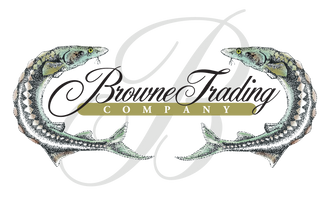
Royal Belgian Caviar Farm

When it comes to caviar, Browne is the only company that includes the country of origin, accurate specie name, and caviar farm on the label. Including the caviar farm brand with our own ensures traceability and the highest quality since the farm's reputation is at stake, too.
Before the ban on wild sturgeon caviar, Browne Trading directly imported wild caviar from the Caspian Sea. Included in Browne Trading’s wild caviar selection was the osetra, sevruga, and of course the famed beluga.
So, where does caviar come from today? The short answer is nearly all sturgeon caviar available on the market today comes from aquaculture farms.
Browne pioneered the importation of farmed caviar in the mid-2000's and brought much of it to the U.S. market, becoming the only U.S. company that co-brands with caviar producers.
Located around the world, some of these sturgeon farms are producing caviar of quality that is getting close to the wild standard. Many of these farms have brood stock of sturgeon that originate from the Caspian Sea.
In this post, we will expand on the Royal Belgian Caviar Company. Located in Belgium, Royal Belgian Caviar gained the reputation for producing some of the highest quality caviar in the world.

Who is Royal Belgian?
Royal Belgian began as a fish feed company in the 1980s. Eventually, the company changed to specialize in sturgeon feed, laying a foundation for sturgeon farming.
In the early 1990s, the head biologist, Dr. Willy Verdonck, started breeding sturgeon for caviar. The first caviar yielded in 2002, making Royal Belgian the first caviar farm in Belgium.
Through years of intensive research, Dr. Verdonck managed to control the breeding cycle of certain sturgeon species. From the fertilization of the egg up to the production of caviar, every step in the farm is meticulously controlled and monitored. This ensures an unrivaled and consistent quality to the Royal Belgian caviars.
Dr. Verdonck is considered an international expert of caviar production, and it is his wife, Mia, that is entrusted with the final grading of their caviar.
What makes Royal Belgian caviar “Royal”

Royal Belgian Caviar being graded and tinned at the farm
Producing pristine quality caviar that will satisfy even the most demanding customers and chefs is not a simple task. From the breeding to the feed, to the harvesting of the eggs, the Royal Belgian team have become world leaders in caviar cultivation.
Their extensive research on the optimum sturgeon nutrition is a fundamental factor for their success. This research began in the late 1980s and, after decades of work, is now perfected. With the ideal feed, Royal Belgian sturgeons produce an egg quality that competes with the traditional wild Russian caviars.
Another factor which ensures the quality of Royal Belgian’s caviar is the advanced methods they utilize to harvest and prepare their caviar. They begin the process by performing an ultrasound on the sturgeon to measure roe size and quality.
Royal Belgian only harvests non-ovulated eggs, which is within tradition for the Caspian Sea region.
Once the caviar has been harvested, the team at Royal Belgian sieve, rinse and measure the eggs. They take extra care to ensure that the caviar from each sturgeon does not get mixed.
If you are interested in learning more about what they are doing at the Royal Belgian Caviar farm then click here for their website and here for their Facebook page.
The Royal Belgian Caviar Selection
Browne Trading currently offers 4 different caviar selections from Royal Belgian.
- Siberian: Mildly sweet, almost buttery flavor
- Sterlet Caviar: extremely rare caviar which has a rich, buttery, creamy taste.
- Platinum: malossol (slightly salted) traditionally prepared caviar.
- Osetra: striking color with a pronounced and pleasing “nuttiness” to the taste.

